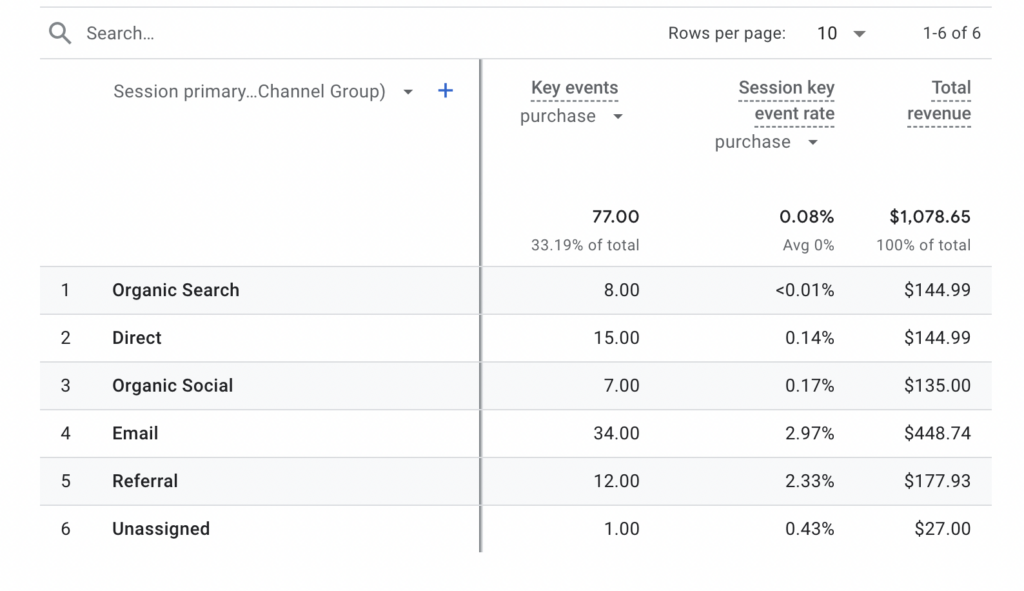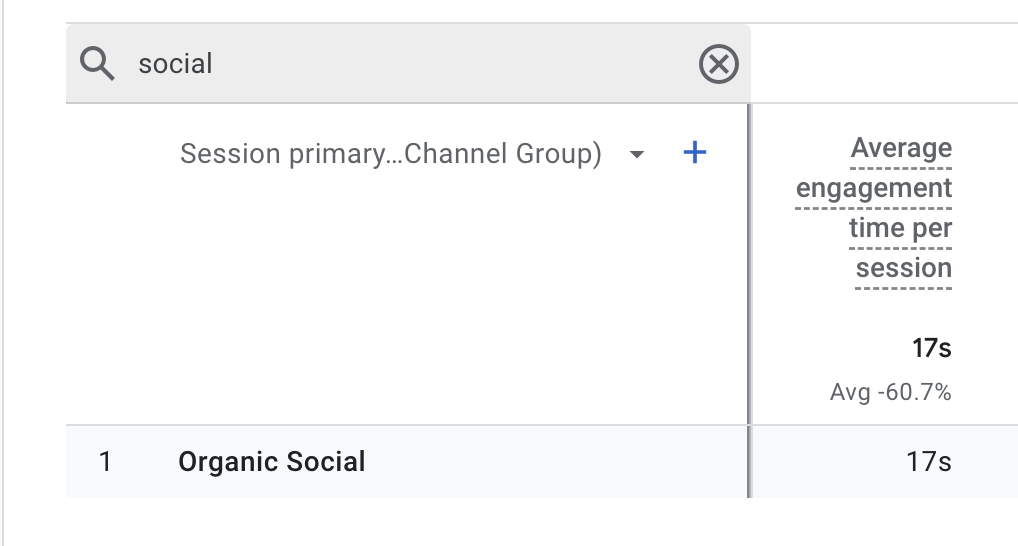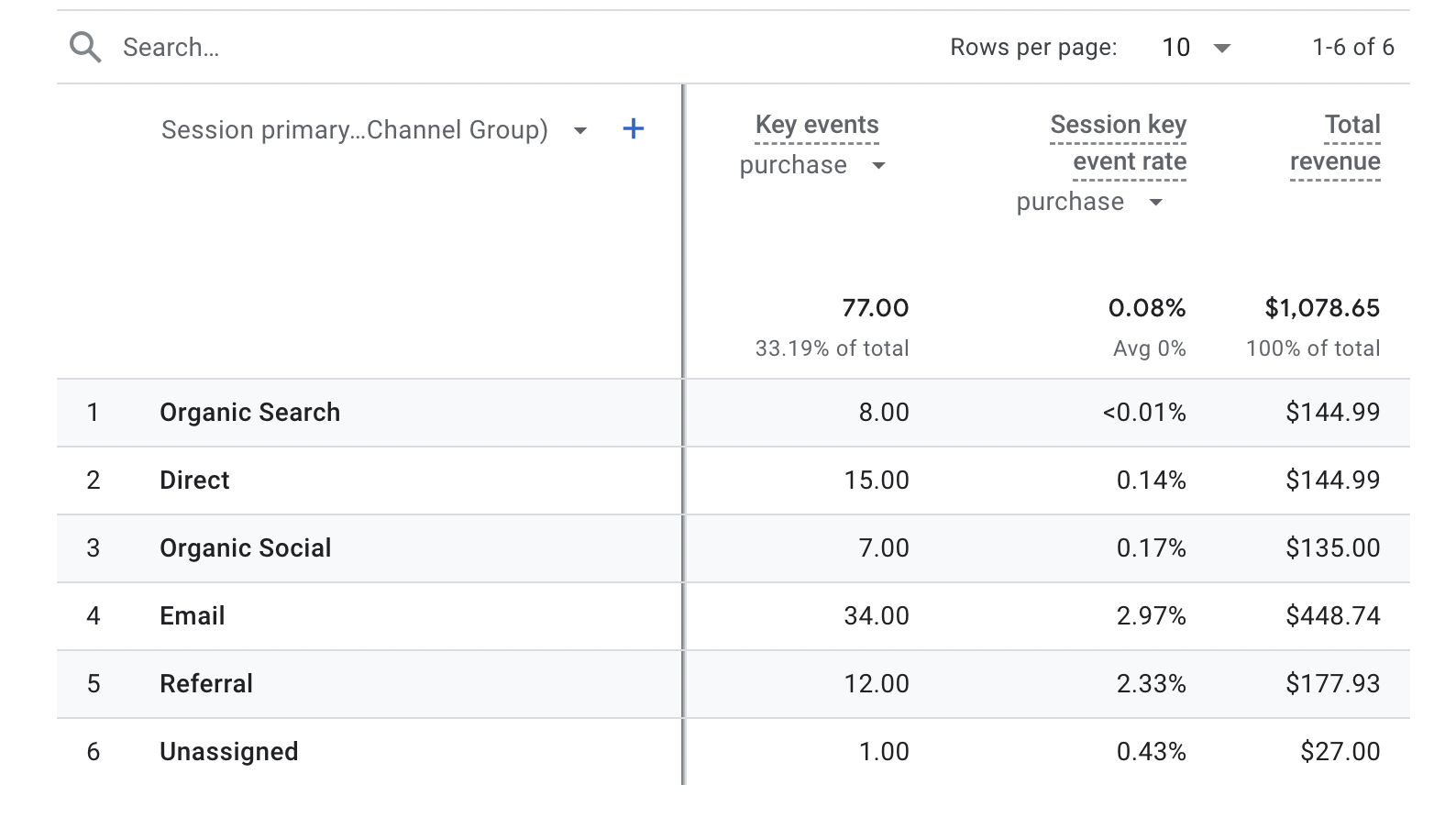A Fractional CMO can help you with your overall marketing strategy, team management, project management, and KPIs.
One of the most impactful ways I help my clients when hired as their Fractional CMO is to dive into their data, and make recommendations based off of their own numbers instead of best practices.
Best practices are great but they are a starting point, not an end-all, be-all.
Let me give you a very high-level overview of how I go about identifying gaps in marketing based on data to help a brand increase their revenue in my role as Fractional CMO.
My Data-Driven Methodology as a Fractional CMO
First, I’ll pop into Google Analytics and look at how all of the brand’s marketing channels are performing from a high level:

If this was your brand, I would be looking at the fact that email is converting at almost 3% but search and social are converting at less than half a quarter of a percent.
A conversion rate of 3% is “industry average” so even though I’d want to dive into how to increase the email conversion rate above 3%, the more important thing to diagnose is why the other channels are underperforming in comparison.
So, let’s say I want to dive into social media to start.
One of the first metrics I’m going to look at is the Average Engagement Time Per Session; this is the average amount of time a visitor has your site open in the foreground of their browser.

What I see here is 17 seconds of average engagement time.
That means some people are spending more time, and some people are spending less time.
The problem is, even if we double 17 seconds to 34 seconds that’s still generally not enough time for most people to read through a sales page, make a purchasing decision, and check-out — so it’s not surprising that the conversion rate is so low.
As a Fractional CMO now I’m on a mission to figure out why the average engagement time is so low and to fix it so that the brand is no longer leaving money on the table.
When we fix it then we are one stop closer to higher conversions because we need people to consume the sales page to purchase.
In many cases the conversions will automatically increase once we change the sales page so that people are more highly engaged, but even if that’s not the case, we’re much closer than we are when they aren’t engaging with the page at all.
So, how do I figure out what to recommend to my client and their marketing team?
First I would look at the messaging on the sales page vs. the messaging on the social media. Is there 1:1 message match, or does the core messaging on the sales page differ from the specific messaging being used on social to drive traffic.
If the messaging is different, I would recommend creating a variation of the sales page that has messaging that is in alignment with the messaging people are engaging with prior to clicking over. When the messaging on a sales page matches the messaging that was clicked on, people know they are in the right place and tend to stick around to learn more.
I would see if that helps.
Second, if the messaging is in alignment then I would look at the page structure. Do we have social proof throughout the sales page, including at least one testimonial high on the page hopefully above or nearly above the scroll? Are the calls-to-action clear? Is the copy skimmable? Is the page long or short?
I would also consider putting HotJar or other similar software on the site to collect heat and scroll maps to see how far down the page most people are scrolling and which parts of the page they are stopping to read and engage with.
If the sales page is quite long, I would I would wonder if the attention span of the people coming over from social media is just too short for a long and wordy sales page.
I might recommend testing a shorter sales page, including video instead of so much copy, and other tweaks that would align with someone who might want a more interactive sales experience.
I would then see if that helps.
Third, if we see that the changes made increase the engagement time but not the conversion rate I would start looking at the pricing and the benefits and deliverables. In many cases, the conversion rate will naturally shoot up as the on page engagement does, but in some cases that won’t happen .
When it doesn’t I would look at pricing and consider, do we need to offer payment plans? Should we try running a sale or offering a discount? How are we priced compared to others in the market compared to what we are delivering?
Are our features and benefits clear or do they leave more questions? Do we need an FAQ section?
And on and on.
There are many, many reasons why an audience might not be converting and a Fractional CMO can lean on their experience to make educated guesses as to why this is happening for your brand, and make recommendations to test based on that.
I walk my clients through this data-driven methodology that leans on testing and optimizing until we’re converting not just at industry average but above it.
The goal is to never stop testing and to always try and beat your own benchmarks!
Of course, this testing and optimization process is only one reason a brand might hire me as a Fractional CMO – but it’s typically the most important reason.
Follow me on Instagram @kayallencarr for marketing tips and resources!
Leave a Reply
Work with the KAC Marketing Team
If you and your team members are wearing multiple hats I'm guessing you don't have the time to do all of the email segmentation, a/b testing, and flow optimization that you know you should be.
This means you're leaving money on the table.
Why not reach out and see if your team and our team would be a good fit to work together? We can take over your email marketing and ads, do all the work your team doesn't have time for, and make sure you're maximizing your revenue!

Be the first to comment